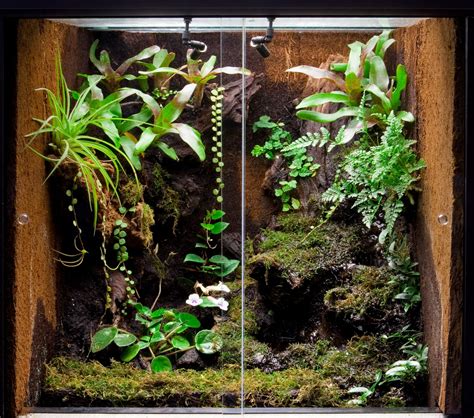Introduction
A bioactive terrarium community is a living ecosystem that recreates the natural habitat of a specific species or group of species. These terrariums are not only beautiful and educational but also provide numerous benefits for the animals that inhabit them.

Components of a Bioactive Terrarium Community
A bioactive terrarium community typically consists of:
- Live Plants: Plants provide oxygen, filter the air, and create a natural environment for animals.
- Substrate: The substrate is the material that covers the bottom of the terrarium and provides a habitat for beneficial microorganisms and invertebrates.
- Microorganisms: Bacteria, fungi, and other microorganisms break down waste and create a nutrient-rich environment.
- Invertebrates: Insects, snails, and other invertebrates help to clean the terrarium and create a natural ecosystem.
- Animals: The animals that inhabit the terrarium are the focal point. They should be compatible with the other components of the ecosystem.
Benefits of a Bioactive Terrarium Community
Bioactive terrarium communities offer numerous benefits, including:
- Natural Environment: They provide a natural and stimulating environment for animals, promoting their health and well-being.
- Reduced Maintenance: The microorganisms and invertebrates in the terrarium help to clean the enclosure, reducing the need for cleaning and maintenance.
- Nutrient Cycling: The microorganisms and plants in the terrarium create a nutrient-rich environment that is beneficial for all inhabitants.
- Educational Value: Bioactive terrariums can teach children and adults about the importance of biodiversity and the interconnectedness of nature.
Trends in the Bioactive Terrarium Community
The bioactive terrarium community is growing rapidly, with more and more people discovering the benefits of these ecosystems. The following are some trends to watch for in the coming years:
- Increased Use of Technology: Technology is being used to improve the monitoring and control of bioactive terrariums.
- New Species: More and more species are being introduced to the bioactive terrarium hobby, expanding the possibilities for creating unique ecosystems.
- Focus on Sustainability: There is a growing emphasis on the sustainability of bioactive terrariums, with a focus on using recycled materials and creating ecosystems that are low-maintenance.
Tips and Tricks for Creating a Bioactive Terrarium Community
Here are some tips and tricks for creating a successful bioactive terrarium community:
- Start Small: Start with a small terrarium and gradually increase the size as you gain experience.
- Research: Do your research and learn about the specific needs of the animals and plants you want to keep.
- Use High-Quality Components: Invest in high-quality plants, substrates, and equipment to ensure the long-term success of your terrarium.
- Be Patient: It takes time for a bioactive terrarium community to establish itself. Don’t expect everything to be perfect overnight.
- Maintain Regularly: Even though bioactive terrariums are low-maintenance, they still require regular care to ensure the health of the animals and plants.
Common Mistakes to Avoid
Here are some common mistakes to avoid when creating a bioactive terrarium community:
- Overcrowding: Don’t overcrowd your terrarium with animals or plants.
- Using the Wrong Substrate: Choose a substrate that is appropriate for the species you are keeping.
- Not Providing Enough Ventilation: Terrariums require proper ventilation to prevent mold and bacteria growth.
- Not Monitoring the Environment: Regularly monitor the temperature, humidity, and other environmental factors in your terrarium to ensure optimal conditions.
- Ignoring the Animals: Don’t neglect the animals in your terrarium. Provide them with food, water, and a hiding place.
Pros and Cons of Bioactive Terrarium Communities
Pros:
- Provides a natural and stimulating environment for animals
- Reduces maintenance
- Creates a nutrient-rich environment
- Educational value
Cons:
- Can be more expensive to set up
- Requires more knowledge and experience
Reviews of Bioactive Terrarium Communities
Here are some reviews of bioactive terrarium communities from the community:
- “I love my bioactive terrarium! It’s so much more interesting than a traditional terrarium, and my animals seem to really enjoy it.” – Emily, Wisconsin
- “I’ve been keeping bioactive terrariums for years, and I’ve never had any problems. They’re a great way to keep a variety of animals in a small space.” – John, California
- “I’m new to bioactive terrariums, but I’m really enjoying it so far. I’m learning a lot, and my animals are thriving.” – Mary, New York
- “I would highly recommend bioactive terrariums to anyone. They’re a great way to learn about nature and provide a natural habitat for your animals.” – David, Texas
Conclusion
Bioactive terrarium communities are a great way to bring nature into your home. They provide a natural and stimulating environment for animals, reduce maintenance, and create a nutrient-rich environment. By following the tips and tricks in this article, you can create a successful bioactive terrarium community that will thrive for years to come.
Frequently Asked Questions
Q: How do I maintain a bioactive terrarium community?
A: Bioactive terrariums require regular maintenance, such as cleaning the glass, misting the plants, and feeding the animals.
Q: What is the best substrate for a bioactive terrarium?
A: The best substrate for a bioactive terrarium is a mixture of organic materials, such as soil, peat moss, and coconut fiber.
Q: What plants should I put in a bioactive terrarium?
A: Choose plants that are appropriate for the species you are keeping and that will help to create a natural environment.
Q: How often should I mist my bioactive terrarium?
A: Mist your bioactive terrarium as needed to maintain the humidity level. This will vary depending on the species you are keeping.





















